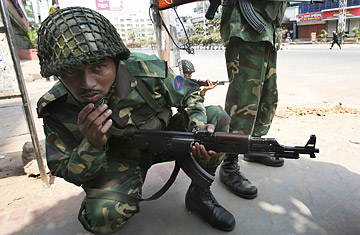
Bangladeshi army troops take position outside the headquarters of Bangladesh Rifles in Dhaka. Mutinous border guards opened fire inside their headquarters and seized a shopping mall in the Bangladesh capital Wednesday, killing one person and wounding several others in an apparent pay dispute
A mutiny by the Bangladesh Rifles (BDR) rocked the country this week, as the paramilitary border guards revolted at their headquarters in Dhaka on Feb. 25, taking most of their high-command officers as hostages and triggering the first political crisis of Prime Minister Sheikh Hasina's new government.
The mutiny began at around 8 a.m. on Wednesday during a meeting between the officers and lower-ranking jawans (soldiers) at BDR headquarters at Pilkhana. They gathered to protest low wages, among other grievances, and the meeting grew increasingly heated as some of the rank-and-file soldiers accused their superiors of failing to bring their long-standing demands to the government. The jawans started firing at the guards and soon took full control of the headquarters. "Nearly 50 people have been killed in sporadic fighting," Mohammad Quamrul Islam, State Minister for Law and Parliamentary Affairs, said on Wednesday. But after the Prime Minister's address Thursday, the rebels who had detained several hundred officers and their family members for the past two days started to release them in groups. The leaders of the ruling Awami League and its political allies entered the BDR headquarters in the city numerous times and managed to evacuate the civilians. (See TIME's Pictures of the Week.)
At least 20 injured people were admitted to Dhaka Medical College and other hospitals in the capital. On Thursday, police retrieved the bullet-ridden bodies of at least six BDR officers from a sewer on the outskirts of Dhaka that connects the BDR headquarters to a nearby river. It is believed that the mutineers shot the officers dead and later threw the bodies into the tunnel.
The BDR mutiny is the first serious challenge to the two-month-old government of Prime Minister Hasina, who was elected late last year in a landslide. She sent two emissaries — State Minister Jahangir Kabir Nanak and Mirza Azam, youth front leader of the Awami League — who entered the BDR headquarters with a white flag to signal that the government was willing to negotiate. After lengthy negotiations in her offices with a delegation of 14 mutineers, the Prime Minister declared amnesty for the BDR soldiers who mutinied if they agreed to lay down their weapons.
But the jawans who remained inside have refused to surrender arms and instead have insisted on written acceptance of their demands by the government. They have said they'll call a cease-fire only after holding talks with the Prime Minister and Home Minister Sahara Khatun (who was involved in the mutineer talks with Hasina). As the crisis continued into Thursday afternoon, Hasina addressed the nation, exhorting the soldiers to stand down. "Lay down your guns immediately and go back to barracks," she said. "Do not force me to take tough actions or push my patience beyond tolerable limits." Government officials confirmed that the rebel soldiers have begun surrendering their arms. About 4,000 guards were believed to be at the headquarters, and it was not immediately clear how many had surrendered. Some 42,000 guards are posted at 64 Bangladesh Rifles camps throughout the country.
The intensity of this crisis brings back to the forefront the biggest issue in Bangladesh in recent years: the role of the army in a democratically elected civilian government. Aside from pay, the jawans' biggest grievance is the practice of deputizing army officers to command units of the paramilitary border guards. The jawans want all such officers to be withdrawn. At one point, the mutineers threw a piece of paper outside the gates to the waiting journalists that read, "We've taken up arms today because we've been repressed by army officers for long."
Sheikh Hasina's victory in December was seen as a triumph for a secular, democratic government over both the Islamist forces within the country and the army, which backed a caretaker government that held power for two years. The anger fueling this mutiny is a sign of just how deep the army's power had extended under that government, which stepped down after the 2008 elections. But in order to fulfill any of her ambitious campaign promises — to stabilize the economy, quell jihadist activity and fight corruption, among others — the Prime Minister needs the cooperation, if not the support, of the army. And so her handling of this crisis will be a crucial test of her ability to balance the frustrations of Bangladeshis who are chafing under a powerful military with her own political imperative to maintain good relations with one of the country's largest, strongest and most stable institutions.
Her task will not be easy. In its effort to control the escalating crisis, the army reasserted its power this week, encircling the BDR headquarters with tanks and moving soldiers into position around it. As army helicopters hovered over the building throughout the day, the mutineers shot at them, demanding the tanks and troops be withdrawn before they would agree to any further talks. So far, most of the other BDR camps around the nation have been calm, but not all of them. In Khulna, a city in southern Bangladesh, the BDR soldiers, inspired by their colleagues' revolt, took control over the Goalkhali BDR camp. This is the BDR's most bloody mutiny in Bangladesh's 38-year-old political history and has taken place in the first 50 days of the Hasina administration. If the civilian government of Bangladesh is unable to come to terms with its military, this mutiny may not be the last.
